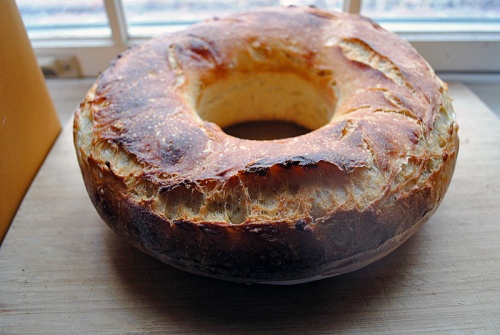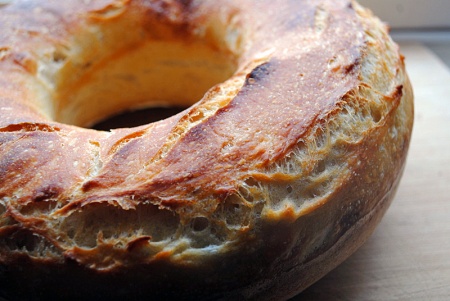First bread post of 2013!
A change from the usual boule or batard, this bread is fun to make, beautiful to look at, and a pleasure to eat! The recipe comes from Local Breads, by Daniel Leader (with Lauren Chattman), a book that any serious bread baker should own. I actually have his first book too, Bread Alone, and keep both volumes together on the shelf as lovely siblings. Bread Alone is an excellent starting point for beginner bread bakers as well as those who want to try their hands at baking with wild yeast. Local Breads is perhaps slightly more “advanced”, lots of sourdough, with formulas that focus on regional recipes that Leader collected through his travels around Europe. Reading his books is like having a master bread baker giving you a private lesson, going through the details that make a difference between a so-so loaf of bread and one that makes you dream.
I wanted my first bread post for 2013 to be special, and this loaf surpassed my expectations. It is surprisingly simple, no special flours, no grains, no seeds. Just a well-fed sourdough starter, the best quality flour you can find, and a little tender loving care to shape the dough and bake it.
 AUVERGNE CROWN
AUVERGNE CROWN
(formula from Local Breads, published with permission from Daniel Leader)
Levain Starter (you will not use the full amount prepared):
45g levain starter, firm (about ¼ cup)
95g unbleached all-purpose flour
5g stone-ground whole wheat flour
50 g tepid water
for the bread:
500g unbleached all-purpose flour
340g water
125g levain (less than the amount prepared above)
10g sea salt
Prepare the levain: Pinch ¼ cup of your stiff levain and place in a bowl with 50 mL water. Mash the levain with a whisk until it dissolves, then add both types of flour and stir. Turn the mixture onto a work surface and knead to fully incorporate the flour. Place the levain in a covered container and let it sit at room temperature (70 to 76°) for 8-12 hours or until it has doubled in volume and the surface is domed.
Make the bread: Pour the water into a large mixing bowl or the bowl stand mixer. Combine the flours until all the ingredients are incorporated. Cover and let it rest for 20 minutes, while the flour hydrates.Uncover the dough, add the salt and the levain and incorporate with your hands or a spatula using a fw firm strokes. Knead the dough with the dough hook by mixing on low-speed (2 on a KitchenAid) for a minute. Increase speed to medium (4 on a KitchenAid) and knead until smooth and muscular; an additional 8 to 9 minutes. Transfer the rounded dough to a lightly oiled container, preferably clear, so you can mark the level of the dough with a masking tape. Let the dough ferment until doubled in size, 3 to 4 hours at a temperature of 70 to 75 F.
Shape the crown. Cover a surface with a little flour. Place the risen dough over the counter and roll it very gently into a long fat rope, about 8 inches long and 3 inches wide. Connect the ends of the rope overlapping by about 4 inches. Press the ends together to seal. Dust a ring baking pan with flour and carefully drop the shaped dough inside. Allow it to proof at 70 to 75 F until it looks “pillowy”, 1 to 1 and a half hours. When you press your finger tip into the dough, it should spring back slowly. As the bread proofs, heat your oven to 425 F and place a large roasting pan, without the lid, inside.
Bake the bread. Once the bread is proofed, slash the outer edge of the round with a razor blade, and place the ring pan inside the roasting pan, and close with the lid slightly moist with tap water. Bake covered for 30 minutes, uncover, remove the ring pan from the oven, carefully invert it to remove the bread, and finish baking the bread sitting on the oven rack, for 15 to 20 more minutes.
Let it cool completely on a rack before slicing through.
ENJOY!
to print the recipe, click here

Comments: In the past, I’ve made a few loaves of ring-shaped breads, and had problems moving the bread to the oven after the final rise. I ended up deflating the dough too much and also messing its shape. This time, I tried something a little different: after shaping the loaf, I placed it in a well-floured ring baking pan, and let the dough go through the final proofing in the pan. When it was time to bake, I quickly scored the outside edge of the dough, and placed the pan and all inside a pre-heated, large roasting pan. The next couple of photos should help explain my strategy, which, I am thrilled to inform, worked quite well!


After 30 minutes baking with the lid closed, I removed the lid, took the ring pan carefully out, inverted it quickly over the counter to release the bread, and placed the bread on the oven rack, without any baking sheet underneath, so that the crust would get a final roasting free of constraints. I like to bake my bread until it’s really dark, because that’s when the taste of the crust delivers the punch I like, the one that transports me to a Parisian bakery…
ABOUT LOCAL BREADS: Ten years passed between Leader’s publication of his first book, Bread Alone, and Local Breads. During that period, he worked with many master bakers in Germany, Italy, and Eastern Europe. In the first chapter of his book, he talks about his bread journey and how he’s gained a special respect for simple but crucial details such as the choice of flour. After a couple of chapters devoted to general lessons on equipment and technique (a must read, by the way), he shares his many recipes in sections divided according to region. He will take you from France to Italy, stop in Germany, Poland, Austria, and the Czech Republic, sampling some of their unique yeast concoctions.
If you enjoy baguettes, you’ll be happy to know that Leader offers recipes for French, Italian, and German baguettes, so you can bake them all and compare their “personalities”. He also shares his recipe for the famous miche from Pain Poilane in France, as well as German Rye Sourdough, two examples of bread that, in my humble opinion, can be quite intimidating. With his detailed instructions, you’ll feel ready to tackle any project, Pain Poilane included! So, if you don’t have Local Breads on your shelf, correct this severe cookbook handicap with a simple click here. 😉
I would like to thank Dan Leader for his permission to publish this great recipe. This post goes straight to Susan’s Yeastspotting!
ONE YEAR AGO: Orange-Pomegranate Chicken
TWO YEARS AGO: The Getty Museum
THREE YEARS AGO: Crowd-Pleasing Pulled Pork

